Dynamic Response of DP Offshore Platform-Riser Multi-Body System Based on UKF-PID Control
Abstract
1. Introduction
2. Methodology
2.1. PID Control Method
2.2. Unscented Kalman Filter Algorithm and Its Principle
2.3. State Estimation and Filtering Model of the Dynamic Positioning Offshore Platform under UKF
2.4. Calling up the Unscented Kalman Filter in Python
2.5. Modeling of DP Offshore Platform-Riser Multi-Body System Based on UKF-PID Control with Python Language Embedded in OrcaFlex
3. Validation
4. Results and Discussion
4.1. Model Establishment
4.2. Calculation Analysis
4.2.1. Effective Tension of Riser under the UKF-PID and Single PID
4.2.2. Bending Moment and Curvature of Riser under UKF-PID and Single PID
4.2.3. Rotation Angle of Riser under the Action of UKF-PID and Single PID
4.2.4. Six Degrees of Freedom of the Offshore Platform under the Action of UKF-PID and Single PID
5. Conclusions
- (1)
- The effect of the UKF-PID dynamic positioning system on the variation of the effective tension of the riser is not significant, which is fully reflected in the fluctuation, coordination, and synchronism of the variation. Compared with the multi-body system controlled by a single PID static positioning system, the bending moment of the platform riser becomes larger when the positioning system is changed. With the addition of the unscented Kalman filter, the strong nonlinearity of riser bending change in the whole system is better reflected. This is helpful for the visual capture of this nonlinearity in engineering practice and the investigation of potential safety hazards and measures to improve safety.
- (2)
- Compared with the dynamic positioning system under the control of a single PID, the bending moment of the riser in the UKF-PID dynamic positioning system and the transmission of bending along the length of the riser will change. This change is mainly reflected in a relatively larger bending moment. The bending moment of the riser at a certain position will be more severe, but the relative hysteresis of the bending moment and curvature still exists. In addition, the hysteresis of load and strain transfer will be further enhanced at some locations. In this case, the overall synchronization and coordination of riser curvature changes along the length direction will be reduced.
- (3)
- The proposed control approach of this paper improves the nonlinearity of the three-degrees-of-freedom translational movements of the offshore platform and modifies the energy distribution in three translation motions of the offshore platform. Under UKF-PID control, the overall motion nonlinearity of the offshore platform-riser multi-body system has been significantly improved. The enhancement of nonlinearity makes the system more sensitive to the change of its own motion response when overcoming the change of external environmental load, which also leads to the increase in the Ry and Rz angles of the riser.
Author Contributions
Funding
Institutional Review Board Statement
Informed Consent Statement
Data Availability Statement
Conflicts of Interest
References
- Altuzarra, J.; Herrera, A.; Matías, O.; Urbano, J.; Romero, C.; Wang, S.; Guedes Soares, C. Mooring System Transport and Installation Logistics for a Floating Offshore Wind Farm in Lannion, France. J. Mar. Sci. Eng. 2022, 10, 1354. [Google Scholar] [CrossRef]
- Amaechi, C.V.; Reda, A.; Butler, H.O.; Ja’E, I.A.; An, C. Review on fixed and floating offshore structures. Part I: Types of platforms with some applications. J. Mar. Sci. Eng. 2022, 10, 1074. [Google Scholar] [CrossRef]
- Amaechi, C.V.; Reda, A.; Butler, H.O.; Ja’E, I.A.; An, C. Review on fixed and floating offshore structures. Part II: Sustainable design approaches and project management. J. Mar. Sci. Eng. 2022, 10, 973. [Google Scholar] [CrossRef]
- Li, C.B.; Chen, M.; Choung, J. The Quasi-Static Response of Moored Floating Structures Based on Minimization of Mechanical Energy. J. Mar. Sci. Eng. 2021, 9, 960. [Google Scholar] [CrossRef]
- Chen, C.; Shiotani, S.; Sasa, K. Numerical ship navigation based on weather and ocean simulation. Ocean Eng. 2013, 69, 44–53. [Google Scholar] [CrossRef]
- Nguyen, V.S. A novel approach to determine the ship position with an azimuth of celestial body and factors of ship route. Int. J. Civil. Eng. Technol. 2019, 10, 1162–1167. [Google Scholar]
- Lee, D.; Lee, S.J. Motion predictive control for DPS using predicted drifted ship position based on deep learning and replay buffer. Int. J. Nav. Arch. Ocean 2020, 12, 768–783. [Google Scholar] [CrossRef]
- Cheng, Z.; Gao, Z.; Moan, T. Numerical modeling and dynamic analysis of a floating bridge subjected to wind, wave, and current loads. J. Offshore Mech. Arct. Eng. 2019, 141, 011601. [Google Scholar] [CrossRef]
- Nagavinothini, R.; Chandrasekaran, S. Dynamic analyses of offshore triceratops in ultra-deep waters under wind, wave, and current. Structures 2019, 20, 279–289. [Google Scholar] [CrossRef]
- Zhang, D.; Bai, Y.; Soares, C.G. Dynamic analysis of an array of semi-rigid “sea station” fish cages subjected to waves. Aquac. Eng. 2021, 94, 102172. [Google Scholar] [CrossRef]
- Loria, A.; Fossen, T.I.; Panteley, E. A separation principle for dynamic positioning of ships: Theoretical and experimental results. IEEE Trans. Control Syst. Technol. 2000, 8, 332–343. [Google Scholar] [CrossRef]
- Dutopo, H.; Marwanto, A.; Alifah, S.; Hidayah, M. Improved ship position stability on offshore-based dynamic position maintenance with the PID method. Tech. Rom. J. Appl. Sci. Technol. 2022, 4, 99–112. [Google Scholar] [CrossRef]
- Hao, L.; Zhang, H.; Li, T.; Lin, B.; Chen, C.P. Fault tolerant control for dynamic positioning of unmanned marine vehicles based on TS fuzzy model with unknown membership functions. IEEE Trans. Veh. Technol. 2021, 70, 146–157. [Google Scholar] [CrossRef]
- Deng, F.; Yang, H.; Wang, L. Adaptive unscented Kalman filter based estimation and filtering for dynamic positioning with model uncertainties. Int. J. Control. Autom. Syst. 2019, 17, 667–678. [Google Scholar] [CrossRef]
- Liu, L.; Zhang, W.; Wang, D.; Peng, Z. Event-triggered extended state observers design for dynamic positioning vessels subject to unknown sea loads. Ocean Eng. 2020, 209, 107242. [Google Scholar] [CrossRef]
- Witkowska, A.; Śmierzchalski, R. Adaptive dynamic control allocation for dynamic positioning of marine vessel based on backstepping method and sequential quadratic programming. Ocean Eng. 2018, 163, 570–582. [Google Scholar] [CrossRef]
- Pettersen, K.Y.; Fossen, T.I. Under actuated dynamic positioning of a ship-experimental results. IEEE Trans. Control Syst. Technol. 2000, 8, 856–863. [Google Scholar] [CrossRef]
- Fossen, T.I. Guidance and Control of Ocean Vehicles. Doctors Thesis, University of Trondheim, Trondheim, Norway, 1994. [Google Scholar]
- Fossen, T.I.; Grovlen, A. Nonlinear output feedback control of dynamically positioned ships using vectorial observer backstepping. IEEE Trans. Control Syst. Technol. 1998, 6, 121–128. [Google Scholar] [CrossRef]
- Skjetne, R.; Fossen, T.I.; Petar, V. Kokotović. Adaptive maneuvering, with experiments, for a model ship in a marine control laboratory. Automatica 2005, 41, 289–298. [Google Scholar] [CrossRef]
- Morawski, L.; Nguyen, C.V. Ship control in maneuvering situation with fuzzy logic controllers. TransNav Int. J. Mar. Navig. Saf. Od Sea Transp. 2008, 2, 77–84. [Google Scholar]
- Lee, G.; Surendran, S.; Kim, S.H. Algorithms to control the moving ship during harbour entry. Appl. Math. Model. 2009, 33, 2474–2490. [Google Scholar] [CrossRef]
- Bui, V.P.; Kawai, H.; Kim, Y.B.; Lee, K.S. A ship berthing system design with four tug boats. J. Mech. Sci. Technol. 2011, 25, 1257–1264. [Google Scholar] [CrossRef]
- Fossen, T.I.; Strand, J.P. Passive nonlinear observer design for ships using lyapunov methods: Experimental Results with a Supply Vessel. Automatica 1999, 35, 3–16. [Google Scholar] [CrossRef]
- Sorensen, A.J.; Strand, J.P.; Fossen, T.I. Thruster assisted position mooring system for turret-anchored FPSOs. In Proceedings of the IEEE International Conference on Control Applications, Kohala Coast, HI, USA, 22–27 August 1999. [Google Scholar]
- Wicher, J.; Van, D.R. Benefits of using assisted DP for deepwater mooring systems. In Proceedings of the Offshore Technology Conference, Houston, TX, USA, 3–6 May 1999. [Google Scholar]
- Aalbers, A.B.; Merchant, A.A. The hydrodynamic model testing for closed loop DP assisted mooring. In Proceedings of the Offshore Technology Conference, Houston, TX, USA, 3–6 May 1996. [Google Scholar]
- Sørheim, H.R. Analysis of motion in single-point mooring systems. Modeling Ident Control 1980, 1, 165–186. [Google Scholar] [CrossRef]
- Wichers, J.E. On the slow motions of tankers moored to single point mooring systems. J. Petro. Technol. 1978, 30, 13–33. [Google Scholar] [CrossRef]
- Lopez-Cortijo, J.; Duggal, A.S.; Van Dijk, R.R.; Matos, S. DP FPSO-A Fully Dynamically Positioned FPSO For Ultra Deep Waters. In Proceedings of the Thirteenth International Offshore and Polar Engineering Conference, Honolulu, HI, USA, 25 May 2003. [Google Scholar]
- Tannuri, E.A.; Saad, A.C.; Morishita, H.M. Offloading operation with a DP shuttle tanker: Comparison between full scale measurements and numerical simulation results. IFAC Proc. Vol. 2009, 42, 249–254. [Google Scholar] [CrossRef]
- Ja’E, I.A.; Ali, M.O.A.; Yenduri, A.; Nizamani, Z.; Nakayama, A. Optimisation of mooring line parameters for offshore floating structures: A review paper. Ocean Eng. 2022, 247, 110644. [Google Scholar] [CrossRef]
- Yan, J.; Qiao, D.; Li, B.; Wang, B.; Liang, H.; Ning, D.; Ou, J. An improved method of mooring damping estimation considering mooring line segments contribution. Ocean Eng. 2021, 239, 109887. [Google Scholar] [CrossRef]
- He, X.; Zhao, Z.; Su, J.; Yang, Q.; Zhu, D. Adaptive inverse control of a vibrating coupled vessel-riser system with input backlash. IEEE Trans Syst. Man Cybern. Syst. 2019, 51, 4706–4715. [Google Scholar] [CrossRef]
- Liu, X.; Liu, Z.; Wang, X.; Zhang, N.; Qiu, N.; Chang, Y.; Chen, G. Recoil control of deepwater drilling riser system based on optimal control theory. Ocean Eng. 2021, 220, 108473. [Google Scholar] [CrossRef]
- Yu, J.; Wang, F.; Yu, Y.; Liu, X.; Liu, P.; Su, Y. Test System Development and Experimental Study on the Fatigue of a Full-Scale Steel Catenary Riser. J. Mar. Sci. Eng. 2022, 10, 1325. [Google Scholar] [CrossRef]
- Aly, A.A.; The Vu, M.; El-Sousy, F.F.; Alotaibi, A.; Mousa, G.; Le, D.; Mobayen, S. Fuzzy-Based Fixed-Time Nonsingular Tracker of Exoskeleton Robots for Disabilities Using Sliding Mode State Observer. Mathematics 2022, 10, 3147. [Google Scholar] [CrossRef]
- Vu, M.T.; Choi, H.; Nhat, T.Q.M.; Nguyen, N.D.; Lee, S.; Le, T.; Sur, J. Docking assessment algorithm for autonomous underwater vehicles. Appl. Ocean Res. 2020, 100, 102180. [Google Scholar] [CrossRef]
- Vu, M.T.; Choi, H.; Nguyen, N.D.; Kim, S. Analytical design of an underwater construction robot on the slope with an up-cutting mode operation of a cutter bar. Appl. Ocean Res. 2019, 86, 289–309. [Google Scholar] [CrossRef]
- Vu, M.T.; Jeong, S.; Choi, H.; Oh, J.; Ji, D. Study on down-cutting ladder trencher of an underwater construction robot for seabed application. Appl. Ocean Res. 2018, 71, 90–104. [Google Scholar] [CrossRef]
- Mobayen, S.; Bayat, F.; Din, S.U.; Vu, M.T. Barrier function-based adaptive nonsingular terminal sliding mode control technique for a class of disturbed nonlinear systems. ISA Trans. 2022, 8, 006. [Google Scholar] [CrossRef]
- Huang, J.; Choi, H.; Vu, M.T.; Jung, D.; Choo, K.; Cho, H.; Nam Anh, P.H.; Zhang, R.; Park, J.; Kim, J. Study on Position and Shape Effect of the Wings on Motion of Underwater Gliders. J. Mar. Sci. Eng. 2022, 10, 891. [Google Scholar] [CrossRef]
- Jin, H.; Cho, H.; Jiafeng, H.; Lee, J.; Kim, M.; Jeong, S.; Ji, D.; Joo, K.; Jung, D.; Choi, H. Hovering control of UUV through underwater object detection based on deep learning. Ocean Eng. 2022, 253, 111321. [Google Scholar] [CrossRef]
- Cho, H.; Jeong, S.; Ji, D.; Tran, N.; Vu, M.T.; Choi, H. Study on control system of integrated unmanned surface vehicle and underwater vehicle. Sensors 2020, 20, 2633. [Google Scholar] [CrossRef]
- Nguyen, N.; Choi, H.; Lee, S. Robust adaptive heading control for a ray-type hybrid underwater glider with propellers. J. Mar. Sci. Eng. 2019, 7, 363. [Google Scholar] [CrossRef]
- Vu, M.T.; Choi, H.; Kim, J.; Tran, N.H. A study on an underwater tracked vehicle with a ladder trencher. Ocean Eng. 2016, 127, 90–102. [Google Scholar] [CrossRef]
- Vu, M.T.; Choi, H.; Kang, J.; Ji, D.; Jeong, S. A study on hovering motion of the underwater vehicle with umbilical cable. Ocean Eng. 2017, 135, 137–157. [Google Scholar]
- Vu, M.T.; Van, M.; Bui, D.H.P.; Do, Q.T.; Huynh, T.; Lee, S.; Choi, H. Study on dynamic behavior of unmanned surface vehicle-linked unmanned underwater vehicle system for underwater exploration. Sensors 2020, 20, 1329. [Google Scholar] [CrossRef] [PubMed]
- Wang, S. On the assessment of thruster assisted mooring. In Proceedings of the Offshore Technology Conference, Houston, TX, USA, 3–6 May 2010. [Google Scholar]
- Bai, Y.; Zhang, D.; Zhu, K.; Zhang, T. Dynamic analysis of umbilical cable under interference with riser. Ships Offshore Struct. 2018, 13, 809–821. [Google Scholar] [CrossRef]
- Sørensen, A.J.; Leira, B.; Peter, S.J.; Larsen, C.M. Optimal setpoint chasing in dynamic positioning of deep-water drilling and intervention vessels. Rob. Nonlinear Control 2001, 11, 1187–1205. [Google Scholar] [CrossRef]
- Leira, B.; Chen, Q.; Sørensen, A.J.; Larsen, C.M. Modeling of riser response for DP control. J. Offshore Mech. Arct. Eng. 2002, 124, 219–225. [Google Scholar] [CrossRef]
- Liu, F. Research on Modeling and Simulating of Dynamic Positioning Control System of the Semi-Submersible Vessel; Wuhan University of Technology: Wuhan, China, 2011. (In Chinese) [Google Scholar]
- Bao, W. Research on Time Domain Analysis of Dynamic Positioning System for Drilling Platform; Jiangsu University of Science and Technology: Zhenjiang, China, 2018. (In Chinese) [Google Scholar]
- Gu, J.; Lu, H.; Yang, J. Studies on coupling dynamic response of TLP in stochastic waves. J. Ship. Mech. 2013, 17, 888–900. (In Chinese) [Google Scholar]
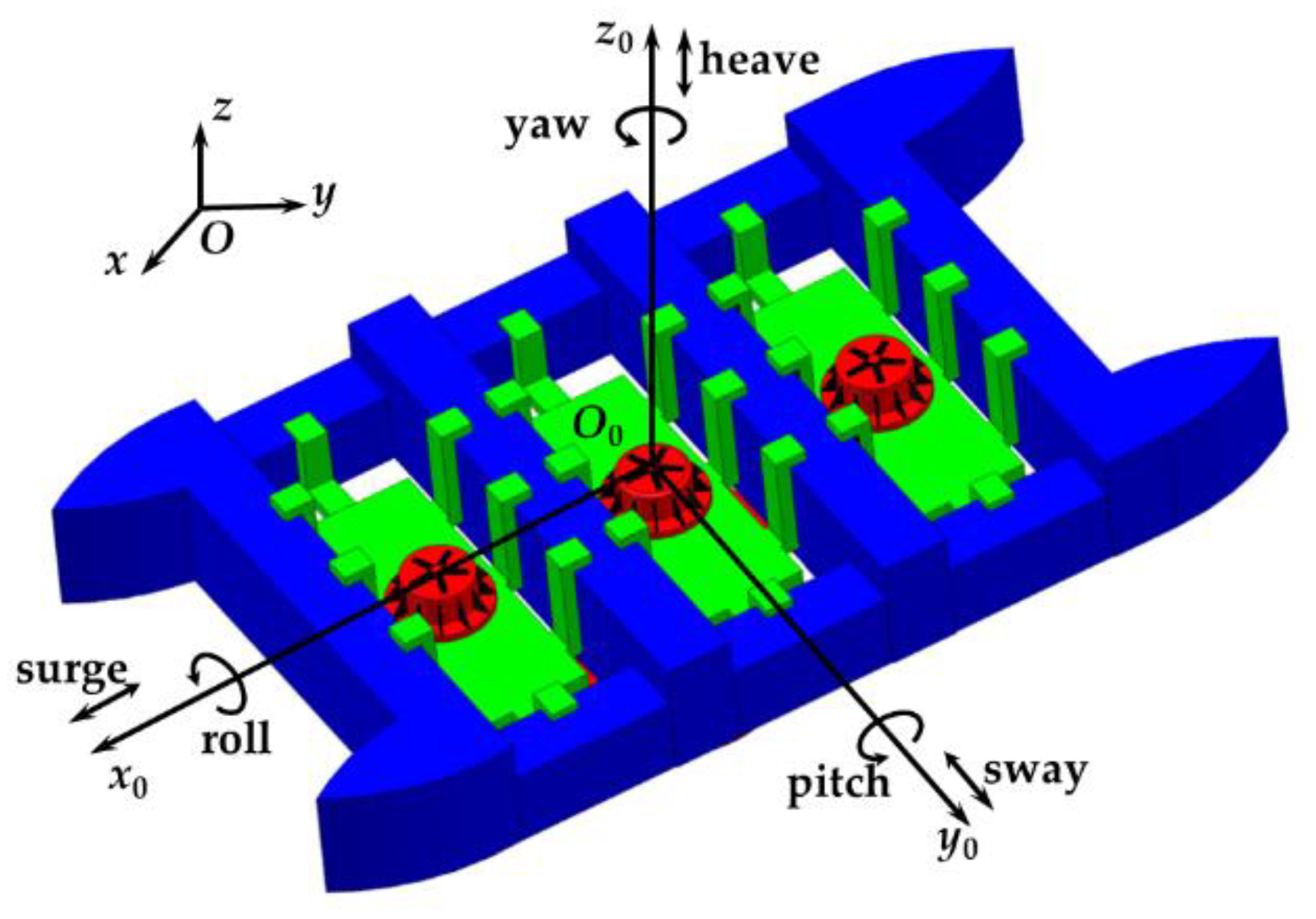

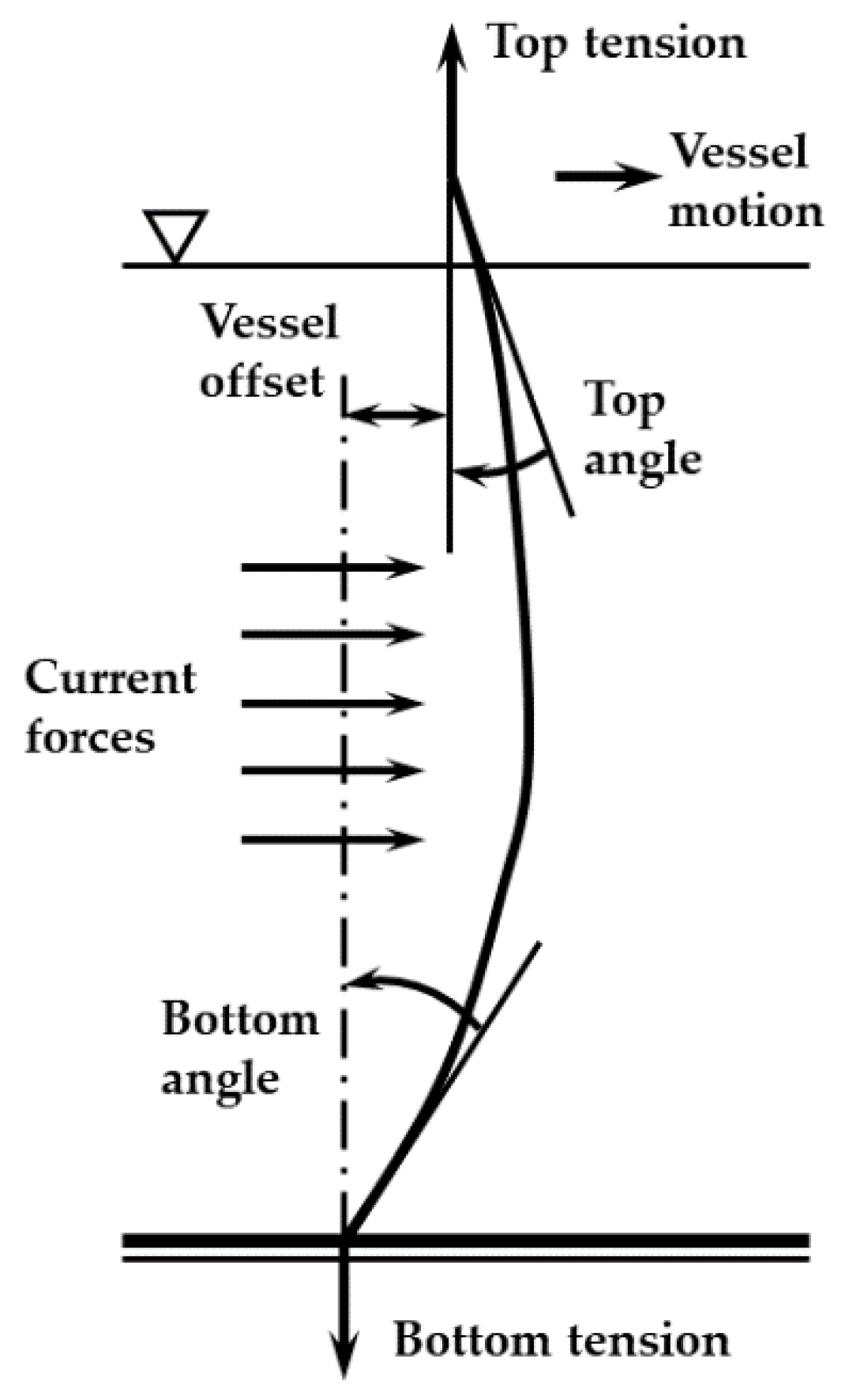

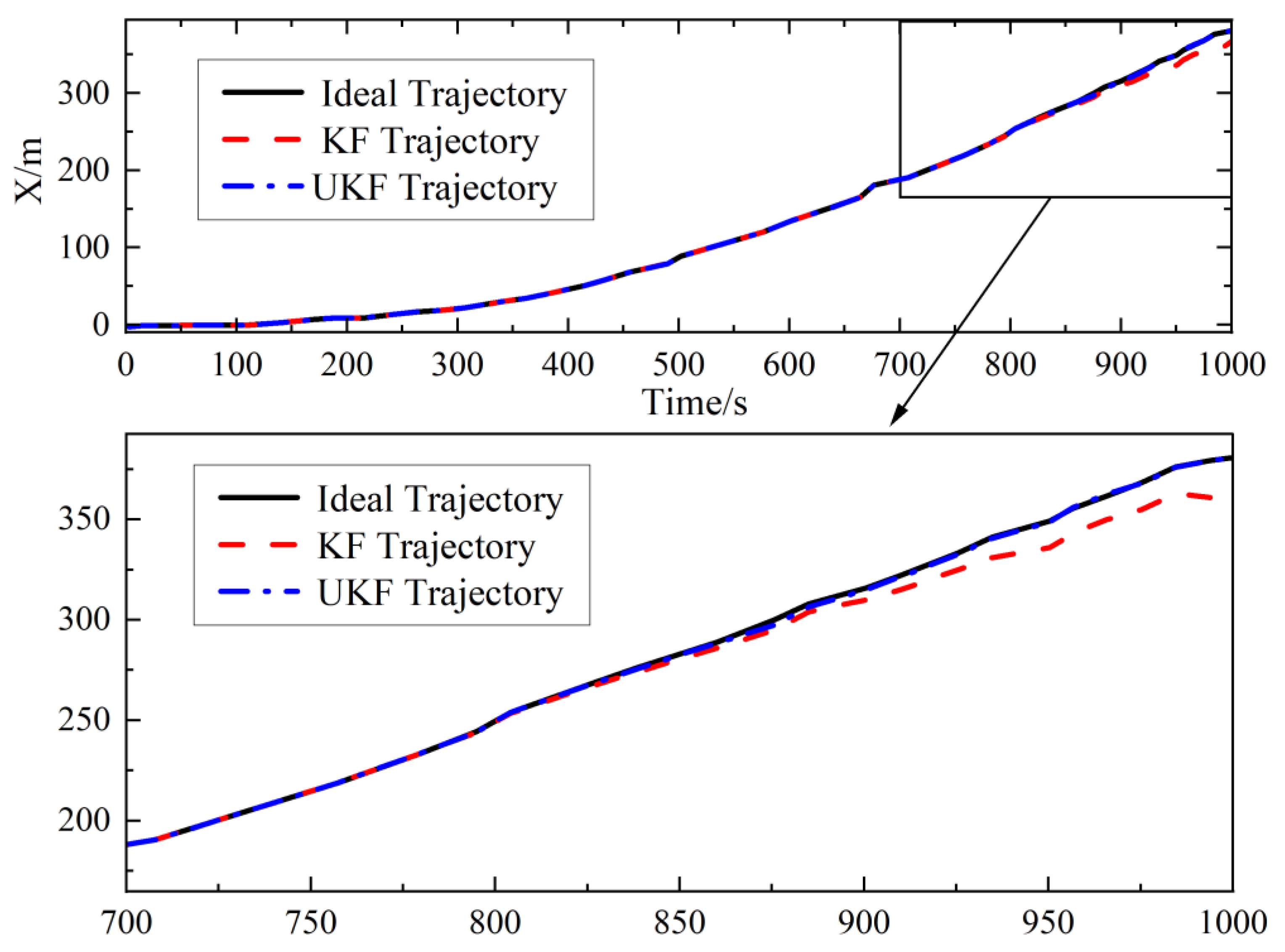
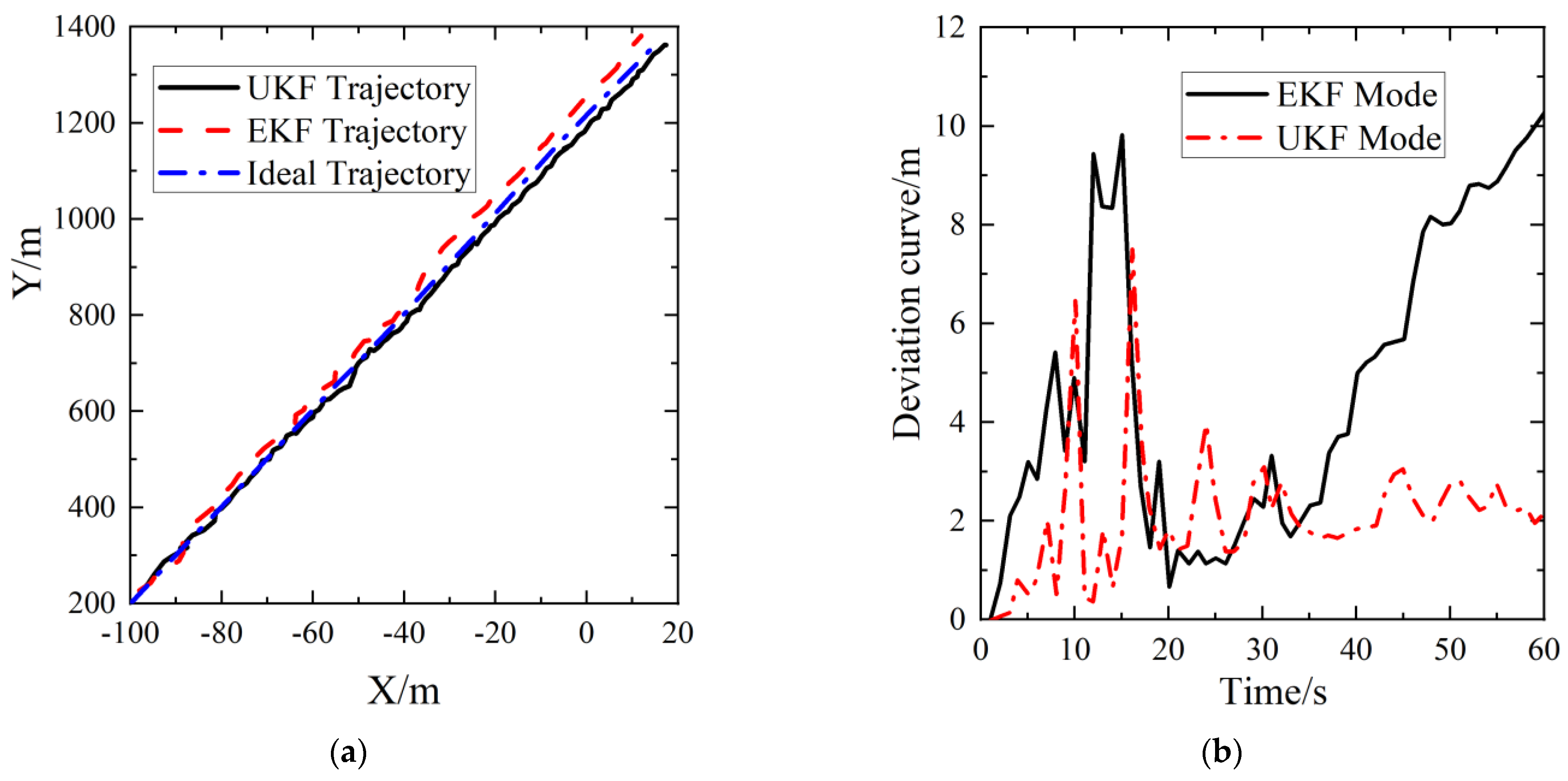
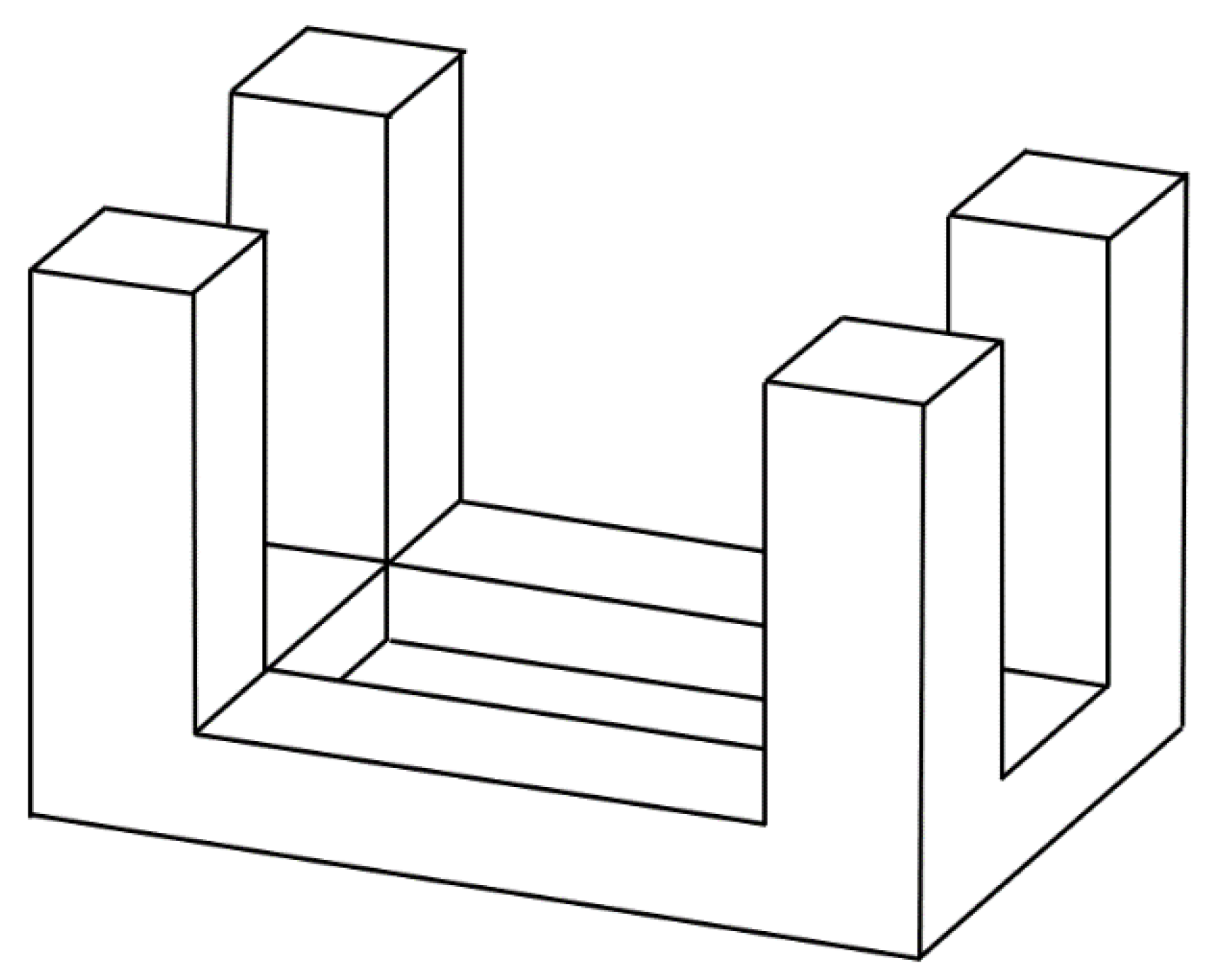

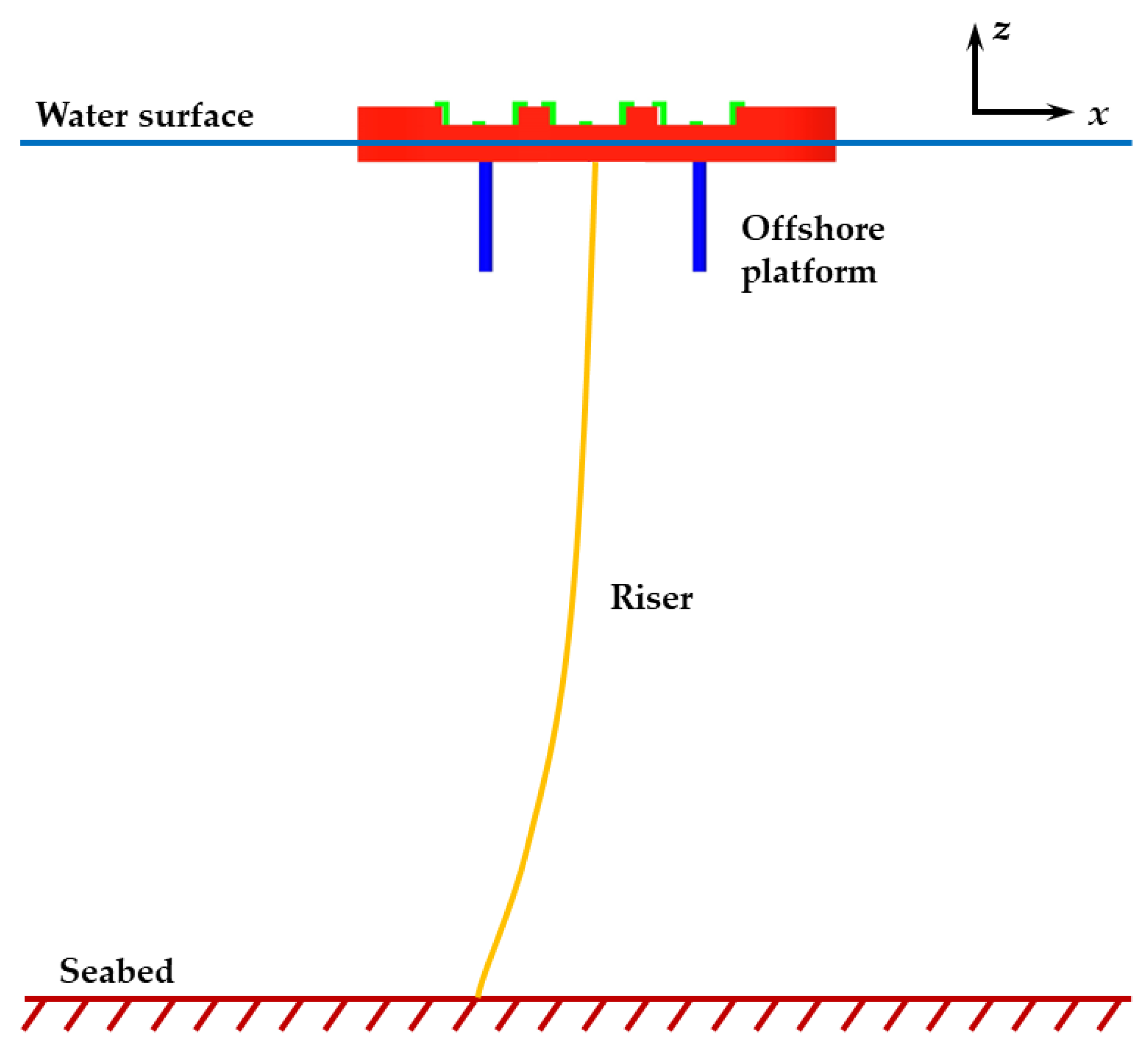
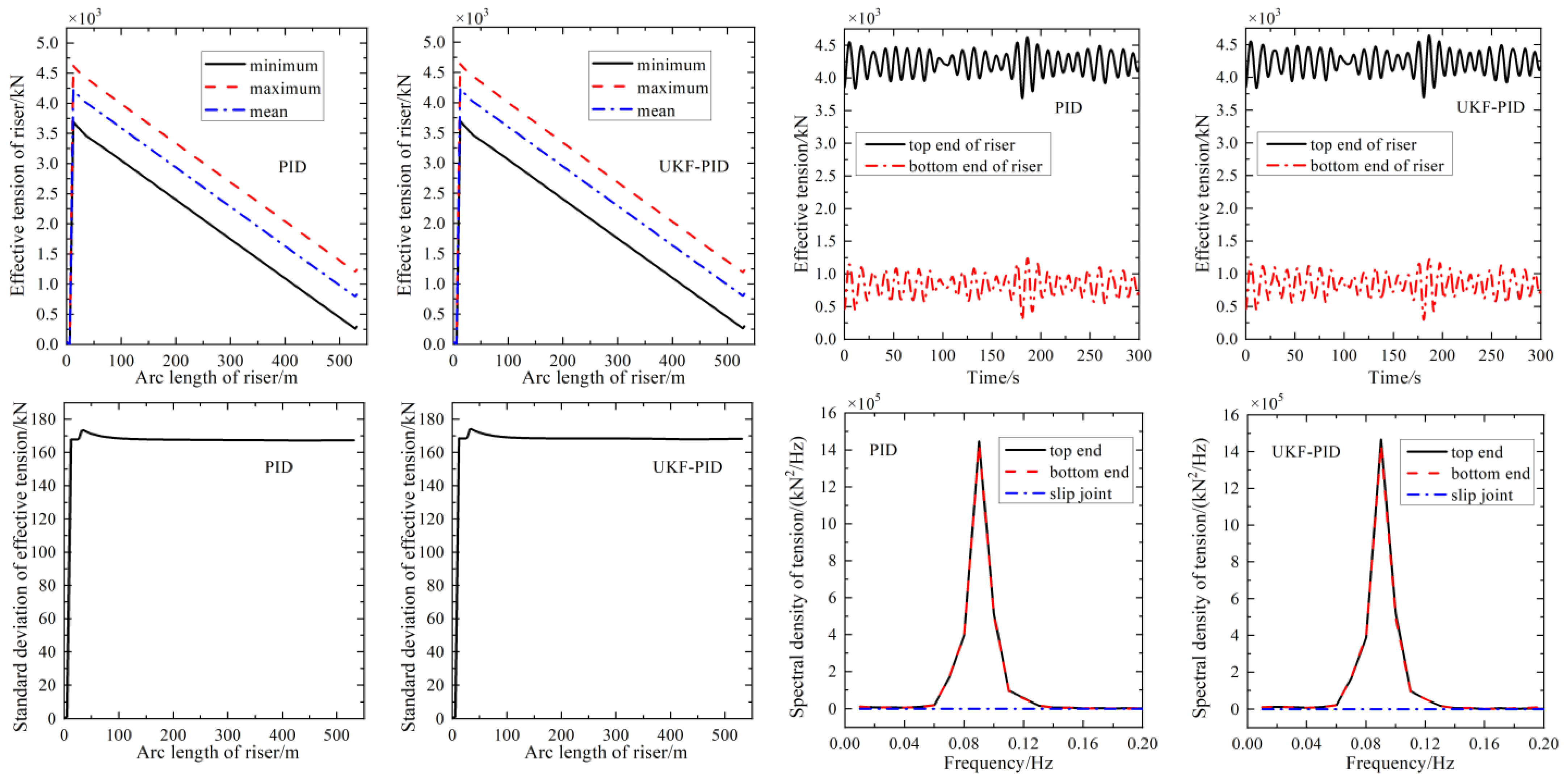
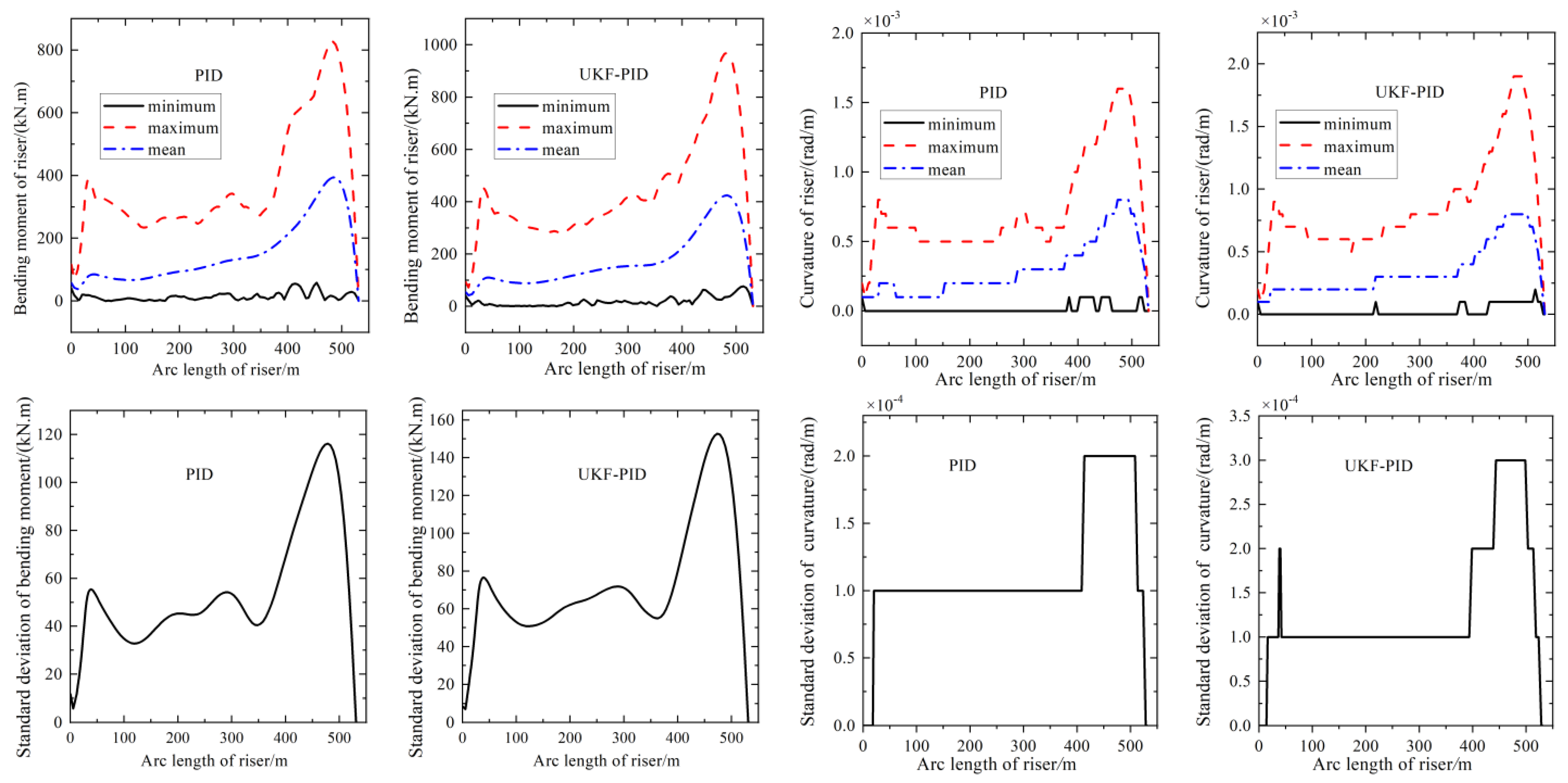



Publisher’s Note: MDPI stays neutral with regard to jurisdictional claims in published maps and institutional affiliations. |
© 2022 by the authors. Licensee MDPI, Basel, Switzerland. This article is an open access article distributed under the terms and conditions of the Creative Commons Attribution (CC BY) license (https://creativecommons.org/licenses/by/4.0/).
Share and Cite
Zhang, D.; Zhao, B.; Bai, Y.; Zhu, K. Dynamic Response of DP Offshore Platform-Riser Multi-Body System Based on UKF-PID Control. J. Mar. Sci. Eng. 2022, 10, 1596. https://doi.org/10.3390/jmse10111596
Zhang D, Zhao B, Bai Y, Zhu K. Dynamic Response of DP Offshore Platform-Riser Multi-Body System Based on UKF-PID Control. Journal of Marine Science and Engineering. 2022; 10(11):1596. https://doi.org/10.3390/jmse10111596
Chicago/Turabian StyleZhang, Dapeng, Bowen Zhao, Yong Bai, and Keqiang Zhu. 2022. "Dynamic Response of DP Offshore Platform-Riser Multi-Body System Based on UKF-PID Control" Journal of Marine Science and Engineering 10, no. 11: 1596. https://doi.org/10.3390/jmse10111596
APA StyleZhang, D., Zhao, B., Bai, Y., & Zhu, K. (2022). Dynamic Response of DP Offshore Platform-Riser Multi-Body System Based on UKF-PID Control. Journal of Marine Science and Engineering, 10(11), 1596. https://doi.org/10.3390/jmse10111596





